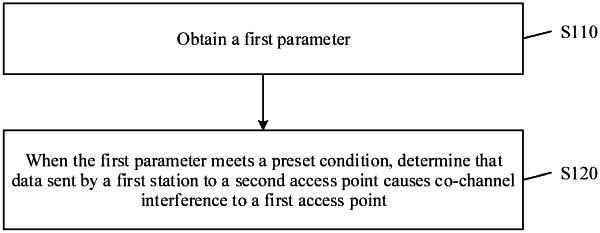| CPC H04L 5/0032 (2013.01) [H04W 72/0446 (2013.01); H04W 72/541 (2023.01)] | 20 Claims |

|
1. An interference source identification method comprising:
obtaining a first parameter comprising a co-channel interference rate of a first access point in a preset time period, a receive channel utilization rate of a second access point in the preset time period, a transmit channel utilization rate of the second access point in the preset time period, and a receive frame rate of first data received from a first station by the second access point in the preset time period, wherein the preset time period comprises a plurality of first sampling periods, wherein the co-channel interference rate comprises a first ratio of a second sampling period and a first time period that the first access point receives interference data in the second sampling period, wherein the receive channel utilization rate comprises a second ratio of the second sampling period and a second time period that the second access point receives wanted data in the second sampling period, wherein the transmit channel utilization rate comprises a third ratio of the second sampling period and a third time period that the second access point sends second data in the second sampling period, and wherein the receive frame rate is of third data received from the first station by the second access point in the second sampling period; and
determining that the first data causes co-channel interference to the first access point when the first parameter meets a first preset condition.
|